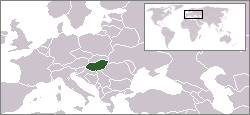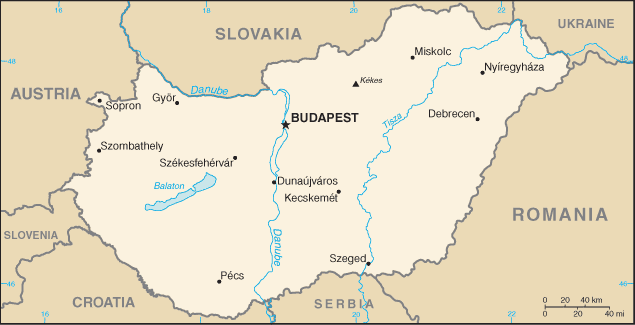Hungary
The Republic of Hungary is a landlocked country in Central Europe, bordered by Austria, Slovakia, Ukraine, Romania, Serbia, Croatia and Slovenia. It is known locally as the Country of the Magyars or Magyarország.
| |||||
| National motto: None | |||||
 | |||||
| Official language | Hungarian | ||||
| Capital | Budapest | ||||
| President | Ferenc Mádl | ||||
| Prime Minister | Ferenc Gyurcsány | ||||
|
Area |
0.74% | ||||
| Population - Total (2001) |
Ranked 78th 10,198,315 | ||||
| Independence (foundation) | December, 1000 | ||||
| Currency | Forint (HUF) | ||||
| Time zone | UTC +1 | ||||
| National anthem | Himnusz (Isten áldd meg a magyart) | ||||
| Internet TLD | .HU | ||||
| Calling Code | 36 | ||||
History
Main article: History of Hungary See Also: Hungary: Pre-History and Early History
Tradition holds that Hungary was founded by Árpád, who led the Magyars into the Pannonian plains in the 9th century. The Kingdom of Hungary was established in 1000 by King St. Stephen I. Initially the history of Hungary was developed in a triangle with that of Poland and Bohemia, with the many liaisons with Popes and Emperors of the Holy Roman Empire. Hungary was totally demolished with a great loss of life in 1241-1242 by mongol armies of the Golden Horde.
Gradually Hungary turned into a large, independent kingdom which formed a distinct Central European culture with ties to greater West European civilisation. Matthias Corvinus ruled Hungary from 1458 to 1490. He strengthened Hungary and its government. Under his rule, Hungary became an artistic and cultural center of Europe during the Renaissance. Hungarian culture influenced others, for example the Polish-Lithuanian Commonwealth. Together with Polish and Czech lands, Hungary formed the Visegrád group of nations. Today an alliance of the same name exists again with the Czech Republic, Slovakia and Poland.
Hungarian independence ended with the Ottoman conquest at the beginning of the 16th century; the parts of Hungary that were not conquered by the Ottomans were annexed by Austria, the rulers of which were Hungarian kings at the same time. Hungarian statedom was preserved by the Principality of Erdély (Transylvania). After 150 years, Austria and her christian allies eventually retook all Hungarian territory by the end of the 17th century from the Ottoman Empire.
After the final defeat of the Turkish, a long struggle began between the Hungarian noble nation and the Habsburg kings for the protection of noblemens' rights (thus guarding the autonomy of Hungary). The fight against Austrian absolutism resulted in the unsuccessful popular freedom fight led by a Transsylvanian nobleman, Ferenc Rákóczi, between 1704-1711. The revolution and partiotic war of 1848-1849 eliminated serfdom and secured civil rights. The Austrians were finally able to prevail only with Russian help.
Thanks to the victories against Austria by the French-Italian coalition (the Battle of Solferino, 1859) and Prussia (Königgratz, 1866), Hungary would eventually, in 1867, manage to become an autonomous part of the Austro-Hungarian Empire, until that Empire's collapse following World War I. Hungary separated from Austria on October 31, 1918.
In March 1919 the communists joined the government, and in April, Béla Kun proclaimed the Hungarian Soviet Republic. This government proved to be short lived; the Romanian army invaded, the communist forces were defeated and the Soviet Republic was toppled on August 6, 1919. In January 1920, elections were held for a unicameral assembly. Admiral Miklós Horthy was elected Regent. In June, the Treaty of Trianon was signed, fixing Hungary's borders. Compared with the prewar Kingdom, the size and population of this new Hungary were reduced by about two-thirds. Miklós Horthy ruled with dictatorial powers for most of the interwar period. Hungarian politics and culture of the era was saturated with irredentism and revisionism (the resurrection of pre-Trianon sized Hungary by whatever means it takes).
Horthy made an alliance with Nazi Germany in the 1930s, in the hope of revising the territorial losses that had followed World War I. Hungary was rewarded by Germany with historical hungarian territories belonging to Czechoslovakia, Yugoslavia and Romania, and took an active part in World War II. However, in October 1944, Hitler replaced Horthy with the Hungarian Nazi collaborator Ferenc Szálasi and his "Nyilaskeresztes" party in order to avert Hungary's defection to the Allied side. During the Holocaust more than 400,000 Jews and several tens of thousands of Gypsies perished in Hungary.
Following the fall of Nazi Germany, Hungary became part of the soviet area of influence and was changed into a communist state following a short period of democracy in 1946-1947. In 1956, a popular revolt and announced withdrawal from the Warsaw Pact were met with a military intervention by the Soviet Union and led to the deposition and execution of the reform-minded communist prime minister Imre Nagy. From the 1960's on to the late 1980's Hungary enjoyed a distinguished status of the happiest barrack within the Eastern Bloc, under the rule of late controversial communist leader János Kádár. In the late 1980s, Hungary led the movement to dissolve the Warsaw Pact and shifted toward multiparty democracy and a market-oriented economy. Following the collapse of the Soviet Union in 1991, Hungary developed closer ties with Western Europe, joined NATO in 1999 and joined the European Union on May 1, 2004.
Politics
Main article: Politics of Hungary
The President of the Republic, elected by the parliament every 4 years, has a largely ceremonial role, but powers also include appointing the prime minister. The prime minister selects cabinet ministers and has the exclusive right to dismiss them. Each cabinet nominee appears before one or more parliamentary committees in consultative open hearings and must be formally approved by the president.
The unicameral, 386-member National Assembly (the Országgyűlés) is the highest organ of state authority and initiates and approves legislation sponsored by the prime minister. A party must win at least 5% of the national vote to form a parliamentary faction. National parliamentary elections are held every 4 years (the last was in April 2002). A 15-member Constitutional Court has power to challenge legislation on grounds of unconstitutionality.
Counties
Main article: Counties of Hungary
Hungary is subdivided administratively into 40 regions. Of these, 19 are counties (megyék, singular - megye) and 20 are so-called urban counties (singular - megyei jogú város), in addition to which there is one capital city (főváros): Budapest. The other 39 are:
| Urban counties | Counties (County Capital) |
|---|---|
|
See also: List of historic counties of Hungary
Geography
Main article: Geography of Hungary
Hungary's landscape consists mostly of the flat to rolling plains of the Carpathian Basin, with hills and lower mountains to the north along the Slovakian border (highest point: the Kékes at 1,014 m). Hungary is divided in two by its main waterway, the Danube (Duna); other large rivers include the Theiss (Tisza) and Dráva, while the western half contains Lake Balaton, a major body of water. The largest thermal lake in the world, Lake Hévíz (Hévíz Spa) is located in Hungary. And the second largest lake in the Carpathian Basin (and probably the largest artificial lake in Europe) is Tisza-tó (Lake Theiss).
Hungary has continental climate, with cold, cloudy, humid winters and warm to hot summers. The relative isolation of the Carpathian Basin makes it susceptible to droughts and the effects of Global Warming are already felt. Average annual temperature is 9.7 °C. Temperature extremes are app. 35 °C in the summer and -29 °C in the winter. Average temperature in the summer is 27-32 °C, in the winter it is 0 to -15 °C. Average yearly fall equals app. 600 milimeters of rain. A small, southern region of the country near Pécs enjoys mediterranean climate.
Economy
Main article: Economy of Hungary
Hungary continues to demonstrate strong economic growth as one of the newest members of the European Union (since 2004). The private sector accounts for over 80% of GDP. Foreign ownership of and investment in Hungarian firms is widespread, with cumulative foreign direct investment totaling more than US$23 billion since 1989. Hungarian sovereign debt was upgraded in 2000 to the second-highest rating among all the Central European transition economies. Inflation and unemployment - both priority concerns in 2001 - have declined substantially. Economic reform measures such as health care reform, tax reform, and local government financing have not yet been addressed by the present government.
Demographics
Main article: Demographics of Hungary
For some 95% of the population, mostly Hungarians, the mother tongue is Hungarian, a Finno Ugric language unrelated to any neighbouring language. Several ethnic minorities exist: Roma (2%), Germans (1.2%), Romanians (0.8%), Slovaks (0.4%), Croats (0.2%), Serbs (0.2%) and Ukrainians (0.1%).
The largest religion in Hungary is Catholicism -Roman and Greek- (approx two thirds of the population), with a Calvinist minority (around 20%) and Lutherans (5%). Most of the country's Jews (1%) live in Budapest.
Several large Hungarian minorities exist across the border in neighbouring countries, notably in Ukraine (in Transcarpathia), Slovakia, Romania (in Transylvania) and Serbia (in Vojvodina).
Culture
Main article: Culture of Hungary
- List of Hungarians
- List of Hungarian rulers
- List of Hungarian writers
- Music of Hungary
- Hungarian cuisine
- Common Hungarian surnames
- Public holidays in Hungary
Miscellaneous topics
- Communications in Hungary
- Transportation in Hungary
- Military of Hungary
- Foreign relations of Hungary
- List of cities in Hungary
External links
- FiloLog's Cross-culture pages (Hungarian Business Culture, Habits, Communication, and Relocation to Hungary)
- History of Hungary - The Corvinus Library
- History of Hungary - Chronological Survey: 2500 BC - 2004 AD
- Hungarian Government Portal - Main (governmental) portal
- Kancellaria.gov.hu - Official prime ministerial site
- House of the Nation - Official parliamentary site
- Travel to Hungary Guide
- Hungarian History (Turanian Lands, Turanian Peoples)
- Hungary in Pictures (Some pictures of Budapest and Hungarian towns)
- Budapest & Hungary Pictures (Hungarian Sights with description)
- Worldguide of Hungary by LonelyPlanet.com
- Country Profile Hungary, tons of material and links
- Istvan Kiszely's Homepage An archeologist about Hungarian Prehistory
- Tourist Information about Budapest, Hungary (Useful info for Tourists)



